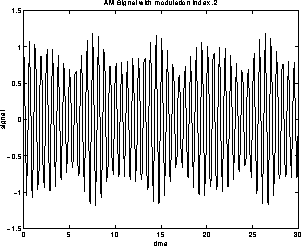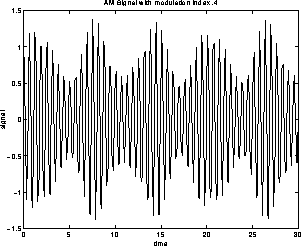
In Amplitude Modulation or AM, the carrier signal

has its amplitude

modulated in proportion to the message bearing (lower frequency) signal

to give

The magnitude of

is chosen to be less than or equal to 1, from reasons having to do with demodulation, i.e. recovery of the signal

from the received signal. The modulation index is then defined to be

Figures 1 and 2 are some matlab plots of what the modulated signal looks like for

. The frequency of the modulating signal is chosen to be much smaller than that of the carrier signal. Try to think of what would happen if the modulating index were bigger than 1.

Figure 1: AM modulation with modulation index .2
Note that the AM signal is of the form

This has frequency components at frequencies

.

Figure 2: AM modulation with modulation index .4
Think of how you might demodulate this signal: that is recover the signal from the modulated signal. The AM stations on your radio go from 550 Khz to 1610 Khz, meaning to say that

radians per second. The maximum frequency

that is transmitted is usually no more than 15 Khz. The bandwidth of an AM scheme which is the amount of space that it occupies in the Fourier domain is twice that of the modulating signal. Thus, for example the radio station KGO 810 occupies roughly the frequency range

radians per second.
The version of AM that we described is called Double Side Band AM or DSBAM since we send signals at both

, and at

. It is more efficient to transmit only one of the side bands (so-called Single Side Band AM or USBAM, LSBAM for upper and lower side bands respectively), or if the filtering requirements for this are too arduous to send a part of one of the side band. This is what is done in commercial analog NTSC television, which is known as Vestigial Side Band AM. The TV video signal has a bandwidth of about 4.25 MHz, but only 1 MHz of the lower side band of the signal is transmitted. The FCC allocates 6 MHz per channel (thus 0.75 MHz is left for the sound signal, which is an FM signal (next section)).
You may have wondered how we can listen to AM radio channels on both stereo and mono receivers. The trick that is used to generate a modulating signal by adding a DSB version (carrier at 38 Khz suppressed) version of the output of the difference between the Left and Right channels added to the sum of the Left and Right channels unmodulated. The resulting modulating signal has a bandwidth of about 60 KHz. A mono receiver gets the sum signal whereas a stereo receiver separates out the difference as well and reconstitutes the Left and Right channel outputs.